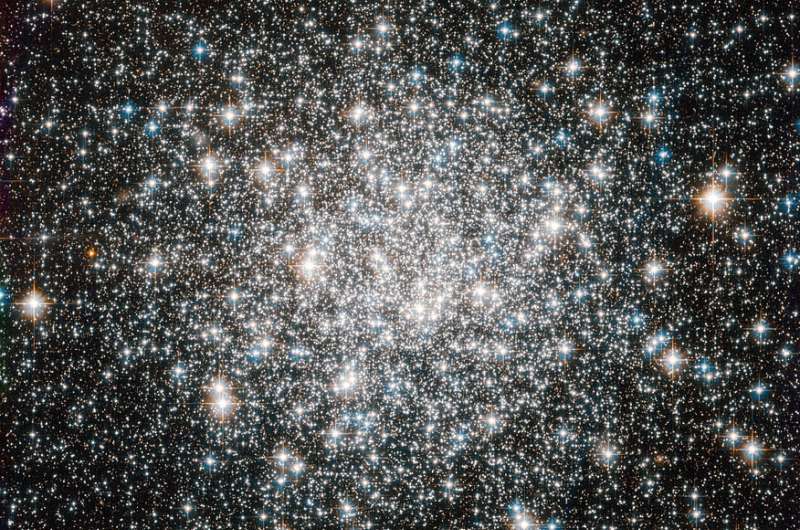February 15, 2022 report
Ultraviolet bright sources inspected in NGC 4590, more than 1,400 stars found in various evolutionary stages

Tomasz Nowakowski
astronomy writer

Using India's AstroSat spacecraft, astronomers have inspected ultraviolet (UV) bright sources in a globular cluster known as NGC 4590 and identified more than 1,400 stellar objects presenting various evolutionary status. The study was published February 8 on arXiv.org.
Globular clusters (GCs) are collections of tightly bound stars orbiting galaxies. Astronomers perceive them as natural laboratories enabling studies on the evolution of stars and galaxies. In particular, globular clusters could help researchers to better understand the formation history and evolution of early-type galaxies as the origin of GCs seems to be closely linked to periods of intense star formation.
GCs are great places to resolve and observe the properties of individual stars of various evolutionary stages. Studies show that sources with effective temperature higher than 7,000 K mostly contribute to the ultraviolet (UV) emission of GCs. Such UV bright sources in GCs may be identified, for instance, as blue horizontal branch stars (BHBs), extremely blue horizontal branch stars (EHBs), or post-asymptotic giant branch stars (pAGBs).
At a distance of about 33,900 light years, NGC 4590 (also known as Messier 68) is a very metal-poor galactic GC in the Milky Way's northern hemisphere. The cluster is estimated to be 11.2 billion years old and its line of sight is at a level of 0.05. Previous observations of NGC 4590 have found that it hosts a significant number of BHBs and red horizontal branch stars (RHBs).
Hoping to get more insights into hot stellar populations of NGC 4590, a team of astronomers led by Ranjan Kumar of the National Institute of Technology in Rourkela, India, decided to investigate this cluster with AstroSat's Ultraviolet Imaging Telescope (UVIT).
"Using UV-optical color-magnitude diagrams (CMDs), we have identified and characterized the sources of different evolutionary stages i.e., blue horizontal branch stars (BHBs), extremely blue horizontal branch stars (EHBs), blue straggler stars (BSs), variable stars, etc." the researchers wrote in the paper.
In general, UVIT observations using using three far-ultraviolet (FUV) and three near-ultraviolet (NUV) filters allowed the team to identify 57 BHBs, 11 RHBs, 246 red giant branch stars (RGBs), 140 sub-giant branch stars (SGBs), 254 main-sequence turn-off (MSTO) stars, 626 main-sequence (MS) stars, 41 RR Lyraes, 31 blue straggler stars (BSs), two SX Phoenicis variable stars (SXPhes) and one asymptotic giant branch (AGB) star.
The study also detected two new FUV bright sources in NGC 4590's core—one of them is an EHB, while the nature of the second one remains unclear. The astronomers assume that this peculiar source is either in its post-blue hook evolutionary phase or in white dwarf (WD) phase.
The researchers found that more massive and younger BSs in NGC 4590 are concentrated at its center, while the older and less massive stars of this type are distributed throughout the cluster. The astronomers added that the normalized radial distribution of the BS stars appears to be bi-modal.
When it comes to the properties of the identified stars, the BHBs are between two and five times larger than the sun, while their masses are within the range of 0.6–0.65 solar masses. The effective temperatures of these stars were calculated to be between 7,250 and 10,500 K.
In the case of RHBs, the smallest one has a radius of about 7.72 solar radii, and the largest is approximately 10.42 times larger than our sun. The masses of the RHBs were estimated to be at a level of 0.65–0.7 solar masses, while their effective temperatures are most likely around 6,000 K.
The identified BS stars have radii between 0.93 and 3.76 solar radii, masses ranging from 0.84 to 1.26 solar masses, and effective temperatures within the range of 5,750–9,000 K. The researchers also managed to determine the age of these stars, finding that they are between 1.5 and 10 billion years old.
Summing up the results, the authors of the paper noted that the dynamical age of NGC 4590 was found to be about 423 million years, which makes it one of the youngest clusters among the dynamically intermediate age galactic GCs. They added that further studies of this cluster are required in order to shed more light on the properties of other stellar groups in this GC.
Written for you by our author —this article is the result of careful human work. We rely on readers like you to keep independent science journalism alive. If this reporting matters to you, please consider a (especially monthly). You'll get an ad-free account as a thank-you.
More information: Ranjan Kumar et al, Study of UV bright sources in globular cluster NGC 4590 using Ultraviolet Imaging Telescope (UVIT) observations. arXiv:2202.03981v1 [astro-ph.GA],
© 2022 Science X Network





















